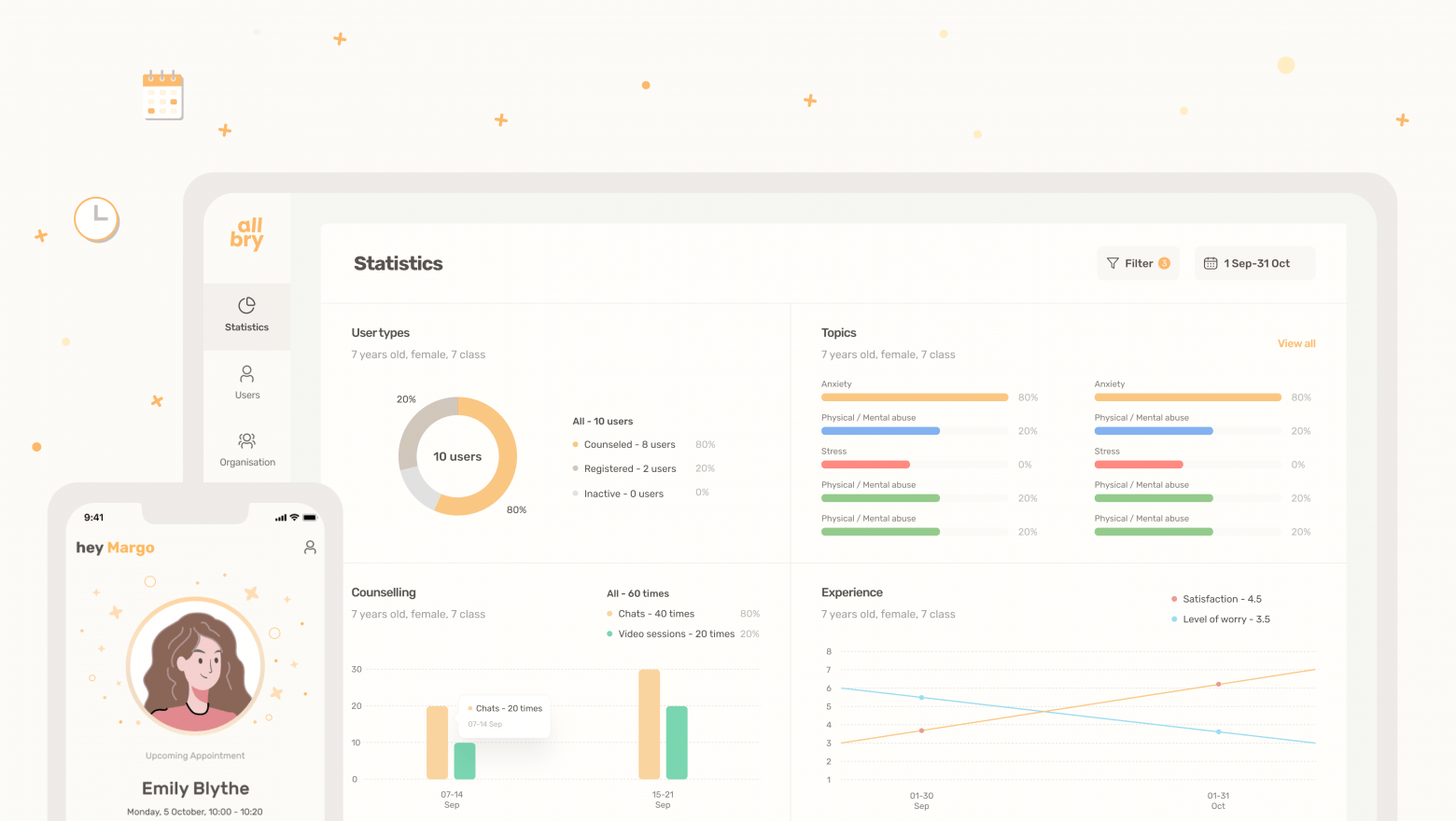Today, we would like to share with you the story that will be especially useful now, during the crisis, when it is necessary to reduce various costs and solve the dilemmas of expensive hiring.
Our task was as follows: to create a more Scalable Version of product asap without hiring in-house specialists, saving resources for a business development, but with a focus on strong architecture and designs to engage more students.
In this article we want to talk about:
- The idea of the product and the detection of problems of potential consumers.
- Difficulties in the development of a telehealth startup and ways to solve them.
- The development process.
With Allbry, we have created a mobile application for students and consultants and a web application for school principals, which provides more effective communication between tutors (teachers/school managers) and students.
Product Idea
The idea of the product is to let students communicate without stress and fear. In addition to direct communication, it allows managers to receive analytics and reports.
In general, the topic of mental health is common even among entrepreneurs or serious professionals who have already reached many heights.
But, for example, our friend Bill in the past, despite his merits, was often upset because of imperfectly completed tasks. Such perfectionism made him suffer. Therefore, the state of young people in schools can be even worse.
A piece of statistics: every year more and more children are diagnosed with mental illnesses, and the percentage of mental disorders is estimated at 40%. That’s the reason we started working on this issue, and that’s why schools are listening to us. We understand that if we do not take serious action to solve this problem, it will continue to grow.
The CEO of Allbry, studying the social work program at the University of Örebro, realized that young people do not have access to support.
The main barrier that prevents others from doing the same without third-party applications is shame. Students are afraid to talk about their mental problems because they think that it will worsen their position in society, or they just underestimate it, thinking that it is not a problem at all.
Again, many parents do not have a basic education about what mental health is and they, too, may miss problems that can result in something more serious.
The solution to this challenge was a tool aimed at responding to students’ problems and correctly analyzing students’ achievements. It can be anonymous and students can ask any question in conversation with the counselor. This opportunity removes a barrier of shame.
In general, this growing issue and lack of action can lead to greater mental health issues: more inertia in schools, fewer sports, and isolation. People will not follow their dreams and take advantage of opportunities.
One of the challenges of our time is speeding up life: for example, the same social networks expect too much from everyone, which leads to more stress, especially for young people.
How did it all start?
Initially, Allbry created another product – a network for universities, which was simply distributed for free. Then they noticed the demand.
The consultants really used the service in their free time. But there was an obstacle in the way of monetization of the service because technical costs had to be covered.
The obstacle was that schools perceived the service fee as something expensive. Therefore, Allbry showed how the product affects people: students spoke and wrote to us, it was a good activity.
The essence of the product is that students quickly and simply find their way to their problems. This can be achieved with the right system of tools, including schools that will be able to see what concerns students are currently having and receive updated statistics.
All these processes were impossible in the previous solution. It was a good platform, but not scalable. Allbry wanted to have a scalable platform and then created a current solution.
Launch
Initially, the CEO of Allbry Cem spoke with specialists who work in this field and were able to give feedback to us and answered our questions.
When we launched at the schools, we received feedback on how they use the platform. For instance, consumers liked the communication part. Also, the statistics and planning system were fascinating for consumers.
The first client started using the platform about a month after the launch, helping about 100 students.
The adaptation went perfectly, and very few critical errors were noticed. Users were able to use the platform without any problems.
After a while, Allbry felt very good when they noticed that almost everything was working smoothly. It was a great feeling that the company went from an idea to development to a real product with users without any serious issues. It was a great relief.
In order to get the current user base of about 10 thousand users, Allbry made sales to new schools and transferred existing users from the old platform to the new one.
Since users are tied to a school that paid for the app, they do not need to find the application themselves, it is usually announced through existing school channels.
The initial scaling process took about 6 months, as Allbry wanted to migrate slowly and steadily and attract new users.
Using this method, it was possible to minimize the number of problems that could arise. Allbry had time to fix potential errors without causing issues for users.
Development process
After Allbry created the MVP, our Nozomi Health team got involved in the process of developing an updated and scalable platform. As CTO Allbry said, they didn’t have time for technical research to create a new platform from scratch that would be scalable, and also lacked architects, infrastructure, the right user interface, and a ready-made development process.
In general, this is a common problem, because of which a lot of time and money resources are lost. At a minimum, it is necessary to maintain constant costs for finding specialists separately and try to create a single working organism from them.
After talking with our European colleagues, we generally realized that new product launches are complicated due to the reluctance to hire new expensive employees and the risks of implementing their competencies.
Outsourcing also has some risks due to the frequent lack of focus in different industries: nuances of legislation in Healthcare or the right UX for doctor-to-patient interaction requires deep expertise.
We have even prepared a small book about solving such a problem. If you are faced with a lack of desire to search and hire each specialist individually or a bad experience with outsourcing teams, you can read our little e-book about the type of interaction that is gaining popularity in Healthcare – Health Product Development at the link Here.
A few words about the kind of development process we had:
1. Firstly, there was the discovery phase, where the joined team discussed the product: we found out the requirements and determined which features we were doing and which were not.
2. Then the design stage, which consists of three phases:
2.1 Concepts are very raw screens that are made to show the architecture of the application.
2.2 Wireframes, when UX applications are already being laid and all user flows are being worked out.
2.3 UI, during which we are already making something beautiful and pleasing to the eye out of raw screens. After the UI of the first features is rendered, we begin development and then the design and dev team work simultaneously.
3. When some kind of scope work was completed, we arranged a demo and watched the result.
In general, it is worth paying attention to point 1. When working together, the criticism of ideas is important, and not just the execution of the originally set task = idea. This is the essence of partnership.
You don’t spend time searching for each individual specialist on LinkedIn, but at the same time you don’t outsource the development of your product completely, not knowing what the result will be in the end.
In fact, we worked as a team. It’s just that Allbry didn’t have to spend time hiring and training/synergizing new people.







